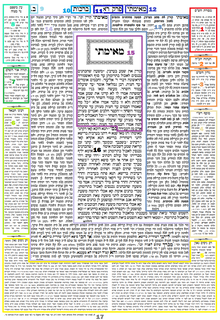“Two Jews, three opinions,” so goes the adage, part inside joke, and part truism. If you have seen a page of the Talmud, it is layered with opinions from centuries of rabbis interpreting, disagreeing, and commenting on previous conversations.

The differences of opinion on the page span not only opinions and generations but also cultures and continents. It is easy to look at the page and forget its most important message, which is that Jews are agreeing to disagree. In agreeing to disagree, they are on the same page.
This particular arrangement goes back to the Bible. Coincidentally, the Jewish liturgical reading of the Torah has this weekend as the transition from Genesis to Exodus. Genesis ends with Jacob blessing his progeny, setting the stage for them to become the twelve tribes of Israel (Israel being his other name). Exodus begins with enumerating the tribes before switching to the grand narrative of the exodus from slavery to freedom.
Interestingly, even after that narrative nominally turns the tribes into the Israelite nation, especially at Mt. Sinai, tribal identity remains present in the whole. The high priest’s breastplate has twelve gemstones, one for each tribe, united and yet distinct. Later, the tribes take positions around the tabernacle as they encamp in the wilderness. Even later still, the tribes unite to conquer Canaan and then settle in different areas. On the breastplate, on the ground, and on maps, the biblical Jews were a nation of sub-groups.
The power of a union made up of differing constituent parts is not such a foreign idea. After all, the United States with its motto of E Pluribus Unum (out of many, one) and its flag (50 stars for each state and 13 stripes for the 13 original colonies) is an example so close to home we might overlook it. There is a difference, though, between representing the idea and making it work, between appearing on the same page and agreeing to be on it.
What does make it work? In the biblical case, freedom from slavery, Moses as leader, and the commandments helped, but they were not always enough. Tribal lands and inheritance had to be worked out in Numbers. When a monarchy was introduced, Saul came from the smallest tribe only to have David come from the biggest right after. In other words, it is not simple.
What actually got Jews on the same page had much to do with seeing dissension and division. In the time of Jesus and the decades after his death, the Jewish community was divided into multiple sub-groups including the first Christians.
Even the rabbinic community was split between two main houses: Beit Shammai and Beit Hillel. Later rabbis went out of their way to point out that in debates between the two, the law generally followed Beit Hillel because they would include the opposing view in their reasoning. They began a tradition of valuing a minority opinion, of preserving dissent. This openness to difference brought together both sides so that later generations could see their place in the argument.
I happen to think it worked then and works now because one side understands what it means to be human by understanding itself as particular, as unique, and honoring that in others. My having a particular position means you must have a particular position. Yes, we could compromise, but each of us giving something up does not always work. We could, instead, value each other’s particularity enough to see how we are the same and thereby find a new solution.
Jewishly, this idea is an extension of the value of seeing each other as created b’tzelem e-lohim (in God’s image), each with divinity in us. It is a universal value demonstrated on a national level by a particular people, the Jews with all our differences. In today’s culture of division, it just might get us on the same page.
About Rabbi Jeremy Winaker
Rabbi Jeremy Winaker is the executive director of the Greater Philadelphia Hillel Network, responsible for West Chester University, Haverford, Bryn Mawr, and other area colleges. He is the former head of school at the Albert Einstein Academy in Wilmington and was the senior Jewish educator at the Kristol Hillel Center at the University of Delaware for four years. Rabbi Winaker lives in Delaware with his wife and three children.


Comments